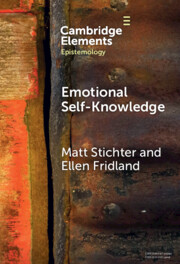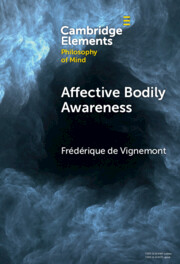Refine search
Actions for selected content:
29 results
Chapter 90 - Multidimensional Assessment of Interoceptive Awareness-2 (MAIA-2)
-
-
- Book:
- Handbook of Body Image-Related Measures
- Published online:
- 21 November 2025
- Print publication:
- 20 November 2025, pp 269-271
-
- Chapter
- Export citation
17 - Biological Systems and Embodiment of the Social World
- from Part IV - Body, Emotion, Self, and Experience
-
-
- Book:
- The Cambridge Handbook of Psychological Anthropology
- Published online:
- 22 October 2025
- Print publication:
- 25 September 2025, pp 412-434
-
- Chapter
- Export citation

Emotional Self-Knowledge
- How Affective Skills Reveal Our Values, Goals, Cares, and Concerns
-
- Published online:
- 09 June 2025
- Print publication:
- 03 July 2025
-
- Element
- Export citation
Chapter 9 - What Is an Emotion?
- from Part Three - What Happens in the Brain when Music Evokes Emotions?
-
- Book:
- Good Vibrations
- Published online:
- 01 May 2025
- Print publication:
- 22 May 2025, pp 195-202
-
- Chapter
- Export citation
Interoception after frontal brain injury: A systematic review
-
- Journal:
- Journal of the International Neuropsychological Society / Volume 31 / Issue 2 / February 2025
- Published online by Cambridge University Press:
- 25 April 2025, pp. 184-193
-
- Article
- Export citation
Dispositional mindfulness, interoceptive awareness, and panic-agoraphobic spectrum, in a general population sample
-
- Journal:
- CNS Spectrums / Volume 30 / Issue 1 / 2025
- Published online by Cambridge University Press:
- 10 February 2025, e36
-
- Article
-
- You have access
- Open access
- HTML
- Export citation
How well can you tell? Success of human categorisation of horse behavioural responses depicted in media
-
- Journal:
- Animal Welfare / Volume 33 / 2024
- Published online by Cambridge University Press:
- 11 November 2024, e50
-
- Article
-
- You have access
- Open access
- HTML
- Export citation
Chapter 3 - Aging Bodies, Brains, and Emotions
- from Part I - Basic Processes
-
-
- Book:
- Emotion Communication by the Aging Face and Body
- Published online:
- 07 December 2023
- Print publication:
- 07 December 2023, pp 54-82
-
- Chapter
- Export citation

Affective Bodily Awareness
-
- Published online:
- 28 September 2023
- Print publication:
- 12 October 2023
-
- Element
-
- You have access
- Open access
- HTML
- Export citation
Chapter 1 - Language as a Physical Tool
- from Part I - Language and Its Power
-
- Book:
- The Freedom of Words
- Published online:
- 20 July 2023
- Print publication:
- 10 August 2023, pp 15-51
-
- Chapter
- Export citation
The Community Resiliency Model, an interoceptive awareness tool to support population mental wellness
-
- Journal:
- Cambridge Prisms: Global Mental Health / Volume 10 / 2023
- Published online by Cambridge University Press:
- 24 July 2023, e43
-
- Article
-
- You have access
- Open access
- HTML
- Export citation
Neurophysiological changes associated with vibroacoustically-augmented breath-focused mindfulness for dissociation: targeting interoception and attention
-
- Journal:
- Psychological Medicine / Volume 53 / Issue 16 / December 2023
- Published online by Cambridge University Press:
- 05 May 2023, pp. 7550-7560
-
- Article
-
- You have access
- Open access
- HTML
- Export citation
Sensitive liberals and unfeeling conservatives? Interoceptive sensitivity predicts political liberalism
-
- Journal:
- Politics and the Life Sciences / Volume 41 / Issue 2 / Fall 2022
- Published online by Cambridge University Press:
- 06 December 2022, pp. 256-275
-
- Article
-
- You have access
- Open access
- HTML
- Export citation
Chapter 2 - Interoceptive Afferent Neurons and Autonomic Regulation with Special Emphasis on the Viscera
- from Part I - The Autonomic Nervous System: Functional Anatomy and Interoceptive Afferents
-
- Book:
- The Integrative Action of the Autonomic Nervous System
- Published online:
- 16 July 2022
- Print publication:
- 04 August 2022, pp 34-70
-
- Chapter
- Export citation
Chapter 11 - TBT-S Neurobiology Psychoeducation Module
- from Section 3 - TBT-S Treatment Interventions
-
- Book:
- Temperament Based Therapy with Support for Anorexia Nervosa
- Published online:
- 31 March 2022
- Print publication:
- 21 April 2022, pp 50-56
-
- Chapter
- Export citation
The role of interoception in the mechanism of pain and fatigue in fibromyalgia and myalgic encephalomyelitis/chronic fatigue syndrome (ME/CFS)
-
- Journal:
- European Psychiatry / Volume 64 / Issue S1 / April 2021
- Published online by Cambridge University Press:
- 13 August 2021, p. S139
-
- Article
-
- You have access
- Open access
- Export citation
The effect of eight yoga sessions on interoceptive accuracy, confidence and awareness in a sample of patients with eating disorder: A preliminary study
-
- Journal:
- European Psychiatry / Volume 64 / Issue S1 / April 2021
- Published online by Cambridge University Press:
- 13 August 2021, p. S353
-
- Article
-
- You have access
- Open access
- Export citation
Noradrenergic activation induced by yohimbine decreases interoceptive accuracy in healthy individuals with childhood adversity
-
- Journal:
- Development and Psychopathology / Volume 34 / Issue 3 / August 2022
- Published online by Cambridge University Press:
- 15 January 2021, pp. 1013-1024
-
- Article
-
- You have access
- Open access
- HTML
- Export citation
Relational and affective neuroscience: a quiet revolution in psychiatric and psychotherapeutic practice
-
- Journal:
- BJPsych Advances / Volume 26 / Issue 6 / November 2020
- Published online by Cambridge University Press:
- 14 October 2020, pp. 356-366
- Print publication:
- November 2020
-
- Article
-
- You have access
- HTML
- Export citation
6 - The Brain as a Cultural Artifact
- from Section 2 - The Situated Brain
-
-
- Book:
- Culture, Mind, and Brain
- Published online:
- 18 September 2020
- Print publication:
- 24 September 2020, pp 188-222
-
- Chapter
- Export citation
